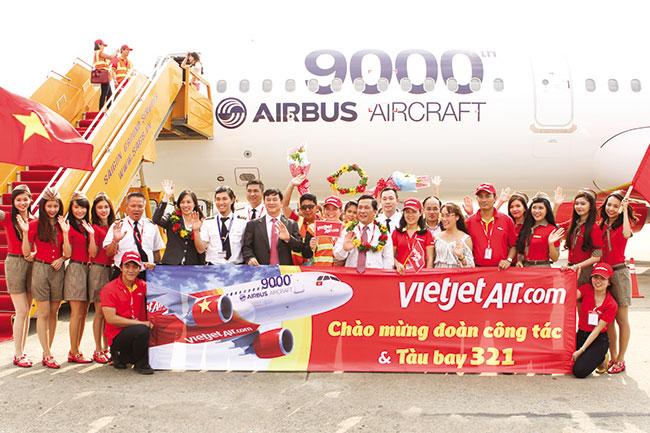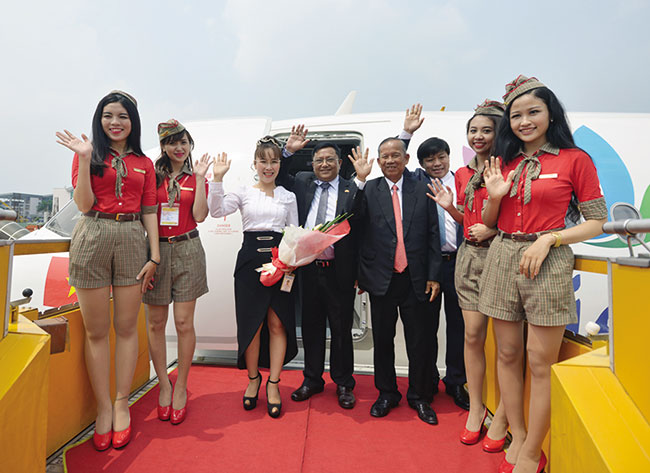Vietjet takes off into ASEAN open sky

The revolution among customers
People from Pleiku, Haiphong, and Vinh have been given cause for excitement as they can now avail of lower airfares to get home in time for the lunar New Year holiday. This is thanks to Vietjet’s recent opening of three new domestic routes: Pleiku-Haiphong, Pleiku-Vinh, and Ho Chi Minh City-Tuy Hoa. The airline has also recently launched its new international route from Hanoi to Taipei, raising their total number of routes to 44.
Vietjet has built up a broad base of loyal customers, who recognise the carrier’s red and yellow planes as symbolic of a low-cost, quality air service that is both friendly and thoughtful. Four years after starting operation, the airline has grown from just three aircraft on the Hanoi-Ho Chi Minh City route to 32 aircraft in its fleet. This figure is set to skyrocket as high as 100 in the near future. Vietjet operates 250 flights a day with a total of 20 million passengers having been carried so far.

Vietjet signed the contract to buy 30 aircraft at the Dubai Airshow
With its lower-priced tickets, the airline has provided flights for many people who thought they could never afford a plane ticket. There are now 60 flights each day between Hanoi and Ho Chi Minh City, operating every 15-20 minutes; 35 flights every day between Hanoi and Danang; and hundreds of other domestic and international flights.
The airline’s new routes have made a direct impact in terms of developing Vietnam’s budding tourism sector, as well as boosting business and trade among various cities and provinces. In this way, the airline is doing much more than just satisfying the people’s demand for transport – it is actively furthering the country’s economic development.
One specific case in point is in the south west region of Vietnam. So far, the airline has flown 5,000 flights here, transporting about 700,000 passengers between various parts of the country. By opening air links between Hanoi, Ho Chi Minh City, Phu Quoc, Danang, and Can Tho, Vietjet actually created the demand by offering cheap tickets, thus facilitating business and tourism in the south west region.
Data from the Civil Aviation Authority of Vietnam (CAAV) showed that in the first six months of 2015, the domestic air transport market grew by 26 per cent, with Vietjet contributing 70 per cent of this growth.
In addition to domestic routes, the airline has opened many international routes to South Korea, Singapore, Taiwan, China, Thailand, and Myanmar, promoting tourism to Vietnam while presenting to the world a prestigious Vietnamese brand and an image of Vietnam as a dynamic country.
The airline plans to increase the number of international routes to 15. Aside from new destinations in Asia such as Japan and Malaysia, the airline is going to open routes to Europe and the US. With its expansion to these well-established markets, the airline looks poised to open a new chapter in its growth story.
“Vietjet has made it its mission to offer Vietnamese people the opportunity to fly, and to do so safely and economically. We want to create a revolution in transport for Vietnamese, developing the domestic air transport sector with a standard of quality on a par with international standards,” said Nguyen Thanh Ha, chairman of Vietjet.

Vietjet opened the Ho Chi Minh City-Yangon route
The revolution among service providers
According to Lai Xuan Thanh, director of the CAAV, Vietjet’s expanding fleet and network have made the domestic air transport sector more competitive. The competition not only benefits customers, who are now able to access cheaper and better-quality services, it also drives changes in the mindset of the government in regulating the sector.
Indeed, government policies
regarding air transport have changed in recent times. Regulatory policies and policies regarding private participation in infrastructure upgrade projects are now approaching international norms and have created a more level playing field for airlines. Another notable contribution in the development of the Vietnamese air transport sector is the airline’s co-operation with international partners. The carrier’s pioneering approach in this area has made collaborative deals with global operators a norm within the industry. Vietjet has signed many contracts to buy and lease aircraft, borrow money and buy insurance, as well as co-operate in service and maintenance with companies from all over the world.
Examples of co-operation include the Memorandum of Collaboration (MOC) with Boeing as the basis for the two to research ways to grow their partnership. The airline is considering buying Boeing aircraft, equipment, and other related services, and co-operate with Boeing in other fields such as fleet development planning, trade terms, training and flight management, public relations, brand building, and finance.
In July, Vietjet signed a memorandum of understanding (MOU) with US multinational Honeywell Aerospace to co-operate in the design and production of $56 million worth of data management equipment on aircraft. The terms of the agreement call for both parties to explore more opportunities for Vietjet to select and install Honeywell’s APU and avionics suite for its new aircraft to be delivered from now until 2017.
In November, Vietjet and Lufthansa Technik AG, a member of Lufthansa AG, yesterday signed a technical service agreement for Vietjet’s current A320-family aircraft engines. Lufthansa committed to supporting Vietjet in new technology training for safety and security assurance as well as researching opportunities for providing spare aircraft parts locally.
In 2016, the domestic air transport market is expected to grow by another 20 per cent to reach 45 million passengers. Of this number, some 26.2 million are domestic passengers, an increase of 23.4 per cent on year. Meanwhile, ASEAN Open Sky – established on January 1, 2016 – creates a level playing field for all airlines in the region. With its stellar achievements over the past four years, Vietjet is brimming with confidence that it can fly even higher in the open skies of ASEAN.
What the stars mean:
★ Poor ★ ★ Promising ★★★ Good ★★★★ Very good ★★★★★ Exceptional
Latest News
More News
- Hainan’s Fresh Fish Gains Global Reach Through Signature Export Initiative (April 24, 2025 | 11:12)
- ACES Awards 2025 Opens Nominations to Celebrate Asia’s Corporate Trailblazers (April 24, 2025 | 10:51)
- CUHK Faculty of Arts Earns Global Recognition as Top Asian Humanities Hub (April 24, 2025 | 10:44)
- CDNetworks Helps Global Firms Enter Emerging Markets with Plug-and-Play Solutions (April 24, 2025 | 10:00)
- MHT advances its 'Back to Basics' strategy (April 23, 2025 | 17:44)
- Vietnam is shaping up for the next wave of mobile (April 23, 2025 | 16:45)
- Vietnamese and Japanese ministries discuss support policies for businesses (April 23, 2025 | 12:13)
- Vietnam’s family businesses at a crossroads amid digital and generational shifts (April 23, 2025 | 12:12)
- Vietnam’s Top Enterprises Invited to Join ACES Awards 2025 (April 23, 2025 | 10:59)
- WRISE Group Launches WRISE Capital to Expand Corporate Advisory Services (April 23, 2025 | 10:47)
















 Mobile Version
Mobile Version